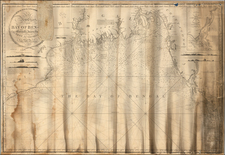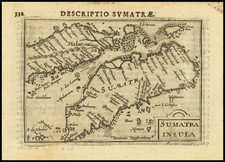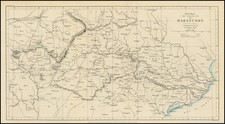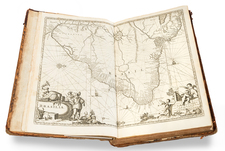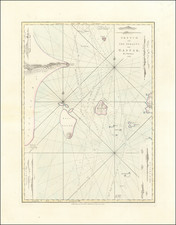A Chart of the Easternmost part of the East Indies and China, From Cape Comarine to Iapan, with all the Adjacent Islands represents a significant contribution by hydrographer Samuel Thornton to the understanding of Southeast Asia in the early 18th century. Published in London circa 1706, this chart offers an extensive depiction of the region, which played a central role in English exploration and trade activities of the period.
This chart appeared in Samuel Thronton's reissue of his father's English Pilot: The Third Book...the Oriental Navigation, which was first issued in 1703. John Thornton had issued that chartbook as a competitor to the Mount & Page Third Book (first issued in 1701), itself a continuation of the exceptionally rare Seller Third Book, first issued in 1675. Samuel took over publication from his father in 1706 or 1708, sources vary (John died in the latter year), before issuing a new edition in 1711.
Context
In the late 17th and early 18th centuries, the East India Company, under a royal charter granted in 1600, maintained the sole privilege for English trade with the East Indies. This expansive region, represented in its entirety on Thornton's chart, stretched from Cape Comorin in India to Japan, encompassing a variety of islands and mainland territories that figured in the company's commercial exploits.
The chart itself exhibits a detailed visual record of these Southeast Asian territories. Regions such as Bengal, Malaya, China, and the Straits of Singapore, among others, are marked, highlighting the English interest in these commercially viable and strategically important areas. The comprehensive depiction also reflects the depth of geographical knowledge the English had acquired through their continual exploration and engagement with Southeast Asia.
Adding to the chart's historical interest is the coat of arms of the East India Company, displayed above the title cartouche. This emblem, indicative of the company's standing between 1600 and 1709, marks the chart as a product of this era, before the company transitioned into the United East India Company. The presence of a misspelling in the company motto—"Deus Indicat" rendered as "Deus Indeat"—serves as a subtle yet intriguing detail.
In sum, Thornton's chart serves as a tangible manifestation of English interests in Southeast Asia in the early 18th century. It provides valuable insights into the state of English exploration, trade, and geographical knowledge during a pivotal time in the expansion of the East India Company.
States of the Map and Rarity
Very rare. We note one example of the first state having appeared in a dealer catalog in the last 30 years.
- 1703 circa: Imprint of John Thornton
- 1706-1708 circa: Imprint of Samuel Thornton
- 1716: Samuel Thornton imprint removed
John Thornton was a respected and prominent chartmaker in London in the latter part of the seventeenth century. He was one of the final members of the Thames School of chartmakers and served as the hydrographer to the Hudson's Bay Company and the East India Company. He produced a large variety of printed charts, maps, and atlases in his career, but he was also a renowned manuscript chart maker. Born in London in 1641, he was apprenticed in the Drapers Company to a chartmaker, John Burston. After being made free of the company (1665), he was part of the combine that took over John Seller’ English Pilot in 1677. Thornton was trusted by the naval and navigational establishment of the day; one of his clients was Samuel Pepys, naval administrator and diarist. Thornton died in 1708, leaving his stock to his son, Samuel, who carried on the business.
Samuel, born in ca. 1665, also had apprenticed in the Drapers Company and was made free a year after his father’s death. He continued the business until 1715, when he died. His stock then passed to Richard Mount and Thomas Page.









